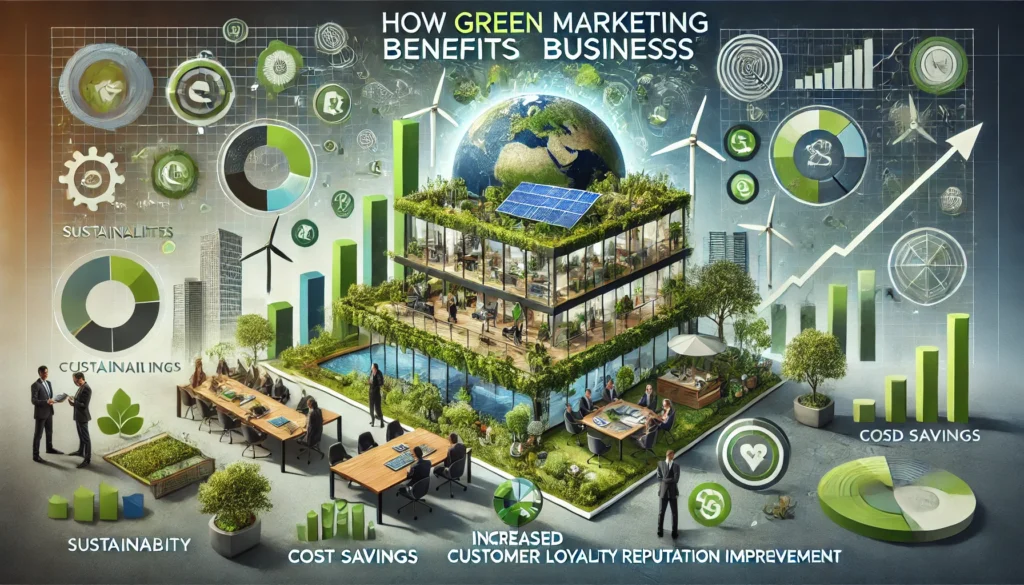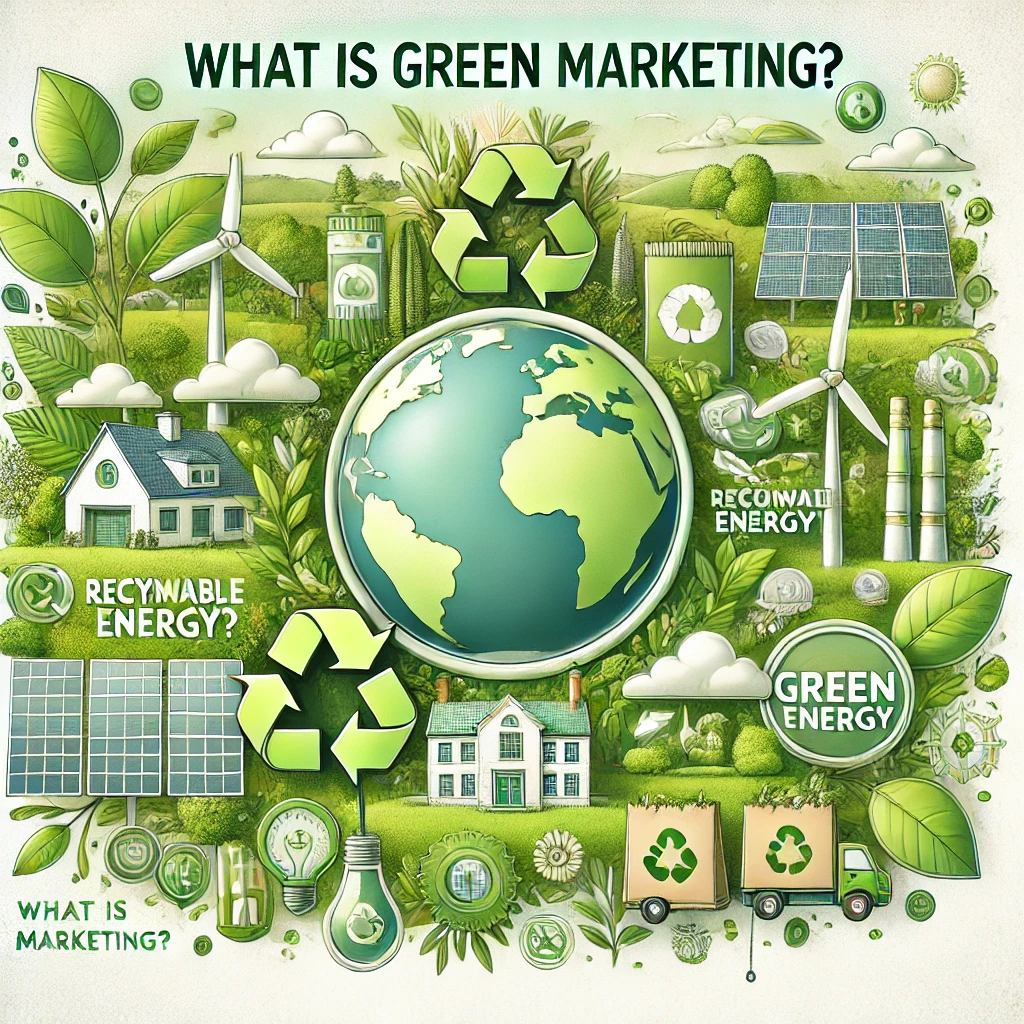In today’s world, consumers are becoming more conscious of their environmental impact, and businesses are responding by adopting sustainable practices. One of the key approaches that companies are embracing is green marketing. But what is a green marketing, and how does it shape modern business practices?
Green marketing, also known as eco-marketing or environmental marketing, is the promotion of products or services based on their environmental benefits. These benefits could include reduced waste, sustainable sourcing, lower carbon emissions, or the use of renewable energy. Green marketing goes beyond just promoting a product—it emphasizes the company’s commitment to protecting the environment and promoting sustainability in all aspects of its operations.
In this detailed guide, we will explore the various dimensions of green marketing, how businesses can integrate it into their operations, and why it matters in today’s environmentally conscious society.
Understanding What is Green Marketing
At its core, what is green marketing? Green marketing is a strategic approach where companies align their products, services, and overall brand with environmentally-friendly initiatives. It involves more than just advertising a product as eco-friendly; it encompasses a company’s entire philosophy about how it manufactures, packages, and delivers goods, aiming to minimize harm to the planet.
The main objective of green marketing is to promote the environmental benefits of a product or service while also making a positive impact on the environment. Companies engaged in green marketing might focus on reducing waste, using recyclable materials, adopting sustainable production processes, or supporting causes related to conservation or energy efficiency.
What is a green marketer? A green marketer is someone who promotes these environmentally responsible products and services, highlighting their sustainability and appealing to eco-conscious consumers. These marketers are tasked with not only ensuring that the products meet certain environmental standards but also effectively communicating the benefits to the target audience.
Why is Green Marketing Important?

Green marketing is important for several reasons, both for businesses and for society as a whole:
1. Growing Consumer Demand for Sustainability
Consumers today are more informed and aware of the environmental challenges facing the world, including climate change, pollution, and deforestation. As a result, many people are now seeking out products and brands that align with their values of sustainability and environmental responsibility.
Green marketing helps companies tap into this growing market segment by promoting products that have a lower environmental impact. Studies have shown that consumers are willing to pay more for products that are eco-friendly, particularly if they know the product has been made sustainably or reduces harm to the planet.
2. Building Brand Loyalty
Companies that practice green marketing often develop stronger relationships with their customers. By promoting sustainability and showing that they are committed to protecting the environment, businesses can build a sense of trust and loyalty among eco-conscious consumers.
This loyalty often translates into repeat business, as customers prefer to support brands that share their values. A company that can demonstrate that it is genuinely working to reduce its environmental footprint will likely gain a competitive edge over businesses that are not as committed to sustainability.
3. Regulatory and Ethical Pressures
As governments around the world introduce stricter regulations regarding waste management, pollution, and sustainability, businesses need to comply with these rules to avoid penalties. Green marketing allows companies to not only meet regulatory requirements but also showcase their environmental stewardship.
Additionally, ethical considerations play a huge role in modern business practices. Many companies now recognize the importance of being socially and environmentally responsible, not just for compliance reasons, but because it’s the right thing to do. This ethical alignment with green marketing principles strengthens a company’s reputation.
4. Positive Environmental Impact
Perhaps the most significant reason why green marketing is important is the positive impact it has on the environment. By focusing on sustainability, companies can reduce their carbon footprint, decrease waste, and promote the use of renewable resources. This helps mitigate the adverse effects of climate change and other environmental issues, ultimately contributing to a healthier planet.
Key Components of Green Marketing
Now that we’ve explored what is green marketing and why it’s important, let’s break down the key components of an effective green marketing strategy:
1. Eco-Friendly Products
At the heart of any green marketing strategy is the product itself. For a company to promote itself as environmentally friendly, its products need to reflect that commitment. This means creating goods that are non-toxic, biodegradable, energy-efficient, or made from sustainable or recycled materials.
For example, a company might produce clothing made from organic cotton or recycled plastic, or a business could create packaging that is fully biodegradable and reduces plastic waste. It’s not enough to simply label something as “green”—the product must genuinely meet environmentally-friendly criteria.
2. Sustainable Production Processes
A key aspect of green marketing involves how products are made. Green marketers focus on reducing the environmental impact of production by implementing sustainable manufacturing practices. This could involve using renewable energy sources (such as solar or wind power), reducing water consumption, or minimizing emissions during the production process.
Sustainable production processes can also include fair trade practices, ensuring that materials are ethically sourced and that workers are treated fairly. For businesses, aligning their production processes with green marketing goals helps create a holistic approach to sustainability.
3. Eco-Friendly Packaging
Packaging plays a crucial role in green marketing. Many consumers are now highly aware of the impact of plastic and non-recyclable packaging on the environment. Companies that want to position themselves as environmentally conscious need to prioritize eco-friendly packaging solutions.
This could mean using biodegradable materials, reducing the amount of packaging overall, or developing innovative packaging that can be reused or repurposed. Packaging that is both functional and sustainable is a key selling point for green marketers.
4. Sustainability-Focused Advertising
Green marketing is as much about the messaging as it is about the products and processes. Companies must communicate their commitment to the environment through transparent and truthful advertising. This includes promoting the environmental benefits of a product without misleading consumers—also known as avoiding “greenwashing” (the act of falsely advertising a product as eco-friendly).
Effective green marketing campaigns should highlight the company’s genuine efforts to reduce environmental impact and explain how their products or services contribute to sustainability. By doing so, businesses can build credibility and trust with consumers.
How Green Marketing Benefits Businesses

Green marketing is not just good for the planet; it’s good for business too. Here are some of the ways green marketing benefits companies:
1. Competitive Advantage
Companies that embrace green marketing gain a competitive edge in their industry. By positioning themselves as leaders in sustainability, they can differentiate their brand from competitors and attract a loyal customer base that values environmental responsibility. This advantage can be particularly useful in industries where consumers are increasingly demanding eco-friendly products.
2. Cost Savings
Although green marketing strategies often require an initial investment—such as developing sustainable products or adopting energy-efficient processes—these initiatives can lead to cost savings in the long run. For example, using renewable energy, reducing waste, or optimizing resource use can lower operating costs and increase profitability.
Additionally, companies that proactively adopt green marketing strategies may avoid potential regulatory fines or penalties related to environmental compliance, further reducing their financial risks.
3. Enhanced Brand Image
A strong reputation as an environmentally-conscious company can significantly enhance a brand’s image. Businesses that are seen as contributing to positive environmental change can attract not only customers but also investors, partners, and employees who share similar values. A green brand image can be a powerful tool for creating long-term value.
4. Innovation and Growth
Green marketing encourages innovation, as companies are pushed to develop new eco-friendly products, explore sustainable technologies, and rethink traditional business models. This drive for innovation can lead to new revenue streams and growth opportunities, as companies can tap into emerging markets for green products and services.
How to Develop a Green Marketing Strategy
Developing an effective green marketing strategy requires careful planning, commitment to sustainability, and a clear understanding of your target audience. Here’s a step-by-step guide to creating a successful green marketing strategy:
1. Evaluate Your Product’s Environmental Impact
Start by assessing the environmental impact of your product or service. Identify areas where you can reduce waste, use more sustainable materials, or adopt cleaner production processes. This step is essential in ensuring that your green marketing claims are backed by genuine efforts to improve sustainability.
2. Set Clear Sustainability Goals
Once you’ve evaluated your product’s environmental impact, set clear, measurable sustainability goals. These could include reducing carbon emissions, eliminating single-use plastics, or achieving a specific level of energy efficiency. Setting these goals will guide your green marketing efforts and demonstrate your commitment to sustainability.
3. Communicate Transparency
Transparency is key in green marketing. Be honest about your sustainability efforts, and avoid making exaggerated claims. Consumers are becoming more adept at spotting “greenwashing,” so ensure that your marketing messages are truthful and backed by real data. Highlight both your achievements and areas where you’re still working to improve.
4. Target the Right Audience
Understand your target audience and tailor your green marketing strategy to their values. Consumers who prioritize sustainability are likely to respond positively to messaging that highlights environmental benefits. Use language and visuals that resonate with eco-conscious consumers, and emphasize the tangible impact of choosing your product or service.
5. Leverage Social Media and Digital Platforms
Use social media and digital platforms to amplify your green marketing messages. Share behind-the-scenes content that showcases your sustainability practices, such as videos of your eco-friendly production processes or interviews with your green marketers. Engaging with your audience online can foster a sense of community and reinforce your commitment to environmental responsibility.
The Role of a Green Marketer

What is a green marketer? A green marketer is responsible for promoting a company’s environmentally friendly products or services while highlighting the company’s overall commitment to sustainability. These marketers craft messages that emphasize the environmental benefits of products, the company’s efforts to reduce its carbon footprint, and how consumers can make a positive impact by choosing eco-friendly options.
Green marketers play a critical role in shaping how a company communicates its sustainability efforts to consumers. Their responsibilities extend beyond traditional marketing tasks to include educating customers about environmental issues and how the company’s products or services contribute to solving these problems. Here are some of the key roles and responsibilities of a green marketer:
1. Developing Eco-Friendly Campaigns
A green marketer must create campaigns that emphasize the environmental benefits of the company’s products. These campaigns should highlight how the product reduces waste, uses renewable materials, or minimizes carbon emissions. The messaging should be clear, concise, and authentic, avoiding exaggerated claims that could lead to accusations of “greenwashing.”
2. Building Consumer Awareness
Part of a green marketer’s role is to raise awareness among consumers about the importance of sustainable choices. This could involve educating them on how to reduce their carbon footprint, promoting the benefits of recycling, or explaining the importance of choosing eco-friendly products. By increasing consumer knowledge, green marketers can influence purchasing behaviors in favor of sustainable products.
3. Aligning with Corporate Sustainability Goals
Green marketers must ensure that all marketing initiatives align with the company’s broader sustainability goals. This involves working closely with product development teams, operations, and other departments to ensure consistency in messaging and strategy. If the company is actively working to reduce its carbon footprint, the marketing team should highlight these efforts to build trust with the audience.
4. Engaging with Eco-Conscious Communities
An effective green marketer understands the importance of building connections with environmentally conscious communities. This can involve collaborating with environmental organizations, attending sustainability-focused events, or sponsoring eco-friendly initiatives. Engaging with these communities not only enhances the company’s reputation but also provides valuable insights into trends and consumer demands in the eco-market.
5. Monitoring and Reporting Impact
Finally, a green marketer is responsible for tracking the success of green marketing campaigns. This includes measuring the environmental impact of the company’s initiatives, such as reduced emissions or the amount of recycled materials used. Providing regular updates on the company’s progress toward sustainability goals builds credibility and demonstrates a commitment to transparency.
Challenges of Green Marketing
While green marketing offers numerous benefits, it also presents unique challenges for businesses. Companies must navigate these hurdles to ensure the success of their eco-marketing strategies.
1. Greenwashing
One of the biggest risks in green marketing is greenwashing, where a company falsely claims that its products or services are environmentally friendly. This can damage the company’s reputation and lead to mistrust among consumers. To avoid greenwashing, businesses must be transparent about their environmental efforts and ensure that all green claims are backed by concrete evidence.
2. Higher Production Costs
Eco-friendly materials and sustainable production processes can be more expensive than traditional methods. This can result in higher production costs, which may need to be passed on to consumers. Businesses must strike a balance between offering sustainable products and maintaining competitive pricing.
3. Limited Market Reach
Not all consumers prioritize sustainability in their purchasing decisions. While green marketing appeals to a growing segment of eco-conscious buyers, companies may face difficulties reaching broader audiences who are less concerned about environmental impact. Green marketers must find ways to communicate the benefits of eco-friendly products to a wider demographic.
4. Regulatory Compliance
Green marketing campaigns must comply with environmental regulations and advertising standards. For example, in many countries, businesses must provide evidence to support any claims they make about the environmental benefits of their products. Failure to meet regulatory requirements can result in legal penalties and reputational damage.
How Green Marketing Benefits Consumers
Green marketing not only benefits businesses but also provides significant advantages to consumers. Here are some of the ways eco-conscious marketing positively impacts the customer experience:
1. Informed Purchasing Decisions
Green marketing helps consumers make more informed purchasing decisions by highlighting the environmental benefits of certain products. When businesses communicate the sustainability of their goods, consumers can choose products that align with their values, reducing their ecological footprint.
2. Access to Healthier Products
Many eco-friendly products are not only better for the environment but also healthier for consumers. For instance, organic or non-toxic products often contain fewer harmful chemicals, providing a safer alternative to traditional goods. Green marketing ensures that consumers are aware of these benefits and can make healthier choices for themselves and their families.
3. Encouraging Sustainable Lifestyles
Green marketing promotes the idea of sustainability beyond the product itself. By encouraging consumers to adopt eco-friendly habits—such as recycling, reducing waste, and conserving energy—green marketing helps create a culture of environmental responsibility. This can lead to broader societal changes, with consumers embracing more sustainable lifestyles.
4. Supporting Socially Responsible Brands
Consumers increasingly prefer to support companies that demonstrate a commitment to social and environmental responsibility. Green marketing connects consumers with brands that share their values, allowing them to contribute to positive environmental change with their purchases.
The Future of Green Marketing

As global awareness of environmental issues continues to grow, green marketing is expected to play an even larger role in business strategies. The future of green marketing will likely involve greater integration of sustainability into all aspects of business operations, from product development to customer engagement.
1. Technology and Innovation
Advancements in technology will likely lead to the creation of even more eco-friendly products and sustainable practices. For example, innovations in renewable energy, sustainable packaging, and waste reduction technologies will provide businesses with new opportunities to enhance their green marketing efforts.
2. Consumer-Driven Change
Consumers will continue to drive demand for eco-friendly products, pushing companies to adopt more sustainable practices. As younger, environmentally-conscious generations gain purchasing power, businesses will need to prioritize green marketing to stay competitive in the marketplace.
3. Increased Transparency
Transparency will become even more critical in green marketing, as consumers demand greater accountability from businesses. Companies will need to provide detailed information about their environmental impact and progress toward sustainability goals, ensuring that green marketing claims are backed by verifiable data.
Conclusion
What is a green marketing? It’s much more than just a trend—it’s a fundamental shift in how businesses operate and communicate with their customers. Green marketing allows companies to align their products and services with the growing demand for sustainability, making a positive impact on the environment while building brand loyalty and trust.
By adopting eco-friendly practices and promoting them effectively through green marketing, businesses can not only differentiate themselves in a competitive marketplace but also contribute to a healthier planet. As consumers continue to prioritize environmental responsibility, green marketing will remain an essential strategy for any business that wants to thrive in the future.
Whether you’re a business looking to implement green marketing strategies or a consumer seeking to support environmentally-conscious brands, understanding what is green marketing is the first step toward a more sustainable future.
FAQs
1. What is a green marketing strategy?
A green marketing strategy focuses on promoting products or services that are environmentally friendly. It involves highlighting a company’s sustainable practices, such as using eco-friendly materials, reducing waste, and lowering carbon emissions.
2. What is the main goal of green marketing?
The primary goal of green marketing is to promote products and services that have a positive environmental impact while also fostering consumer awareness of sustainability. It aims to reduce environmental harm and appeal to eco-conscious consumers.
3. How does green marketing benefit businesses?
Green marketing helps businesses build a strong brand reputation, attract environmentally-conscious consumers, and gain a competitive edge. It can also lead to cost savings through sustainable practices and compliance with environmental regulations.
4. What is a green marketer?
A green marketer promotes environmentally responsible products and services. Their role is to create marketing campaigns that highlight the sustainability of the product, educate consumers, and build brand loyalty around eco-conscious values.
5. What are examples of green marketing?
Examples of green marketing include companies promoting products made from recycled materials, businesses using renewable energy to power their operations, and brands reducing plastic waste by using biodegradable packaging.
6. What is the difference between green marketing and traditional marketing?
Green marketing specifically focuses on promoting the environmental benefits of products or services and prioritizes sustainability. Traditional marketing, on the other hand, primarily focuses on the product’s features, benefits, and appeal without emphasizing environmental responsibility.




